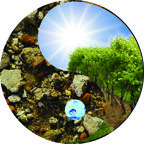 While a sustainably grown vineyard might look serene and peaceful, there is a great deal of activity going on at undetectable levels. Microbes are breaking down organic matter to feed the plants. Pests and diseases are fighting with beneficial organisms that protect the vines. All of these actions result in better fruit production and, in turn, finer wines.
While a sustainably grown vineyard might look serene and peaceful, there is a great deal of activity going on at undetectable levels. Microbes are breaking down organic matter to feed the plants. Pests and diseases are fighting with beneficial organisms that protect the vines. All of these actions result in better fruit production and, in turn, finer wines.
Sustainable production techniques are simply a return to the methods used before World War II, before we learned how to synthesize and concentrate chemicals. These products were soon applied to agriculture to produce fertilizers, herbicides and fungicides that were more concentrated and immediately effective, but took the ecosystem out of the equation.
The main point of growing without chemicals (organic), using the rhythms of the solar system and treatments of natural substances (biodynamic) or with reduced levels of chemicals (integrated pest management, sustainable) is to ensure that vineyard employees are protected and that our land, air and water are maintained in optimal condition for future generations.
Organic matter is a key point of sustainability. Feed the micro-flora in the soil and they feed the plant. This basic premise is bypassed by using chemicals that kill the very organisms that would normally feed the vines. Organic matter is added in the form of manure, compost, pomace and the residue of cover crops. This attracts and provides habitat for beneficial insects and reduces the amount of water and nutrients available to the vine, which in turn reduces excess vigor.
The micro-flora feeds the vine and also creates symbiotic relationships, such as that between mychorrizal fungi and vine roots, which produces enzymes that make nutrients readily available. Chemicals eliminate these processes and injure native beneficial organisms, reducing biodiversity. The tolerances developed to chemicals by the targeted pest insects and plants mandate their future continued use in increased volumes.
Chemical residues stay in the soil, sometimes long after application (the reason for a three-year period without their use for organic and biodynamic certification). These residues can infiltrate the groundwater and runoff, causing problems downstream, such as algae blooms and wildlife kills, that impact growing conditions great distances from the field where they were originally used. Reducing chemical inputs into any vineyard is not only the responsible approach, it usually results in better fruit quality and focused flavors that are transmitted to the wine.
There are challenges to growing sustainably. There are no immediate fixes for problems in many systems, and the organic/biodynamic farmer in particular might have to accept some loss of yield, a major challenge in an already uncertain industry.
There are also inconsistencies in sustainable growing. Natural extracts from plants, such as Pyrethrum and Rotenone, are just as powerful and dangerous as synthesized products. Increased paperwork has prevented many producers from listing their growing methods on the label, and some top producers follow the principles of sustainability but don’t seek third-party certification because they sell out of their inventory every vintage.
Most importantly, growing fruit and making wine are two very different skill sets, the reason why many early followers of sustainability released wines of dreadful quality, creating long-lasting negative memories with the consumer.
Despite the challenges and inconsistencies in moving toward sustainable growing, it is the best approach to preserving our environment in prime condition for future generations.
Terminology
Sustainable: Crops are grown in such a manner that vineyards and environment will continue to produce undiminished volume and quality for future generations, protecting the environment, worker’s well-being and economic sustainability. The focus is to protect against soil depletion, erosion, water pollution, loss of biodiversity and chemical resistance/dependence.
Integrated Pest Management: A long-term, common-sense approach to sustainability combining biological, cultural and chemical solutions that minimizes economic, health and environmental risks.
Transitional: Growers who have used conventional methods in the past and are in transition to organic methods.
Certified Organically Grown Grapes: Grapes that have received certification by an independent third party after no chemical use for three years. Biodiversity is encouraged, as is weed control by cover crops, hoeing, plowing, mulching or mowing. Soil friability and fertility is maintained through composting. Sulfur and copper are allowed for fungal prevention.
Biodynamic (certified by Demeter): Certification after three years without any chemical applications. Farms use herbal sprays and composting techniques developed by Rudolf Steiner and follow the biodynamic calendar based on movement of the planets. Fruit must be hand picked. The vineyard/farm’s goal is to be biodiverse and self-sustaining with ecological, social and economic sustainability.

